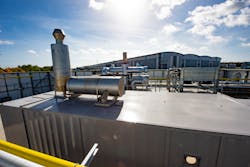Rolls-Royce bringing mtu Gas-fired Gen-sets backing 2-MW Microgrid at UK Industrial park
The logistics development side of a British real estate development firm will build a microgrid that will include on-site natural gas-fired standby power generators for its new energy center.
Energy project developer BasePower has selected Rolls-Royce to provide its mtu microgrid solution for the 2-MW energy center at Symmetry Park. The center is a joint venture with BasePower and real estate logistics firm Tritax Symmetry to provide lower-carbon energy resources for clients at Symmetry Park in Biggleswade, United Kingdom.
The Rolls-Royce portion of the microgrid contract will include two mtu Series 4000 standby generators. Those natural gas-powered gen-sets will provide backup for the Energy Center that will also contain rooftop solar photovoltaic panels, batteries and a combined heat and power (CHP) plant.
The microgrid will help deliver sustainable electricity supply augmenting the local grid. Rolls-Royce full delivery notables includes three mtu CHP plant systems, two mtu EnergyPack battery containuers and microgrid controls.
“One of the priorities our clients have when deciding a new location for their business is power,” Tom Lemming, development director at Tritax Symmetry, said in a statement. “As a responsible developer, we realized the need to supplement and enhance the national grid supply to ensure continual, robust and greener alternative power supply... The installation of energy centers on our parks will provide tenants at the site with greater resilience, more competitive energy and a pathway to fully net zero carbon.”
Tritax Symmetry is a logistics development subsidiary of Tritax Big Box REIT plc. Its collaboration with BasePower at Symmetry Park in Biggleswade is the first under their new partnership.
BasePower is the designer, developer and operator of the energy center projects for Tritax.
The mtu QL battery pack can store 2MWh for deployment when needed in varying times of load demand. The Series 4000 gas-fired generator has a power range of between 775 to 2,535 kW (2.53 MW).
German-based engine manufacturer MTU was part of Daimler-Chysler and later Torgnum until Rolls-Royce acquired the later in 2011.
-- -- --
(Rod Walton, senior editor for EnergyTech, is a 15-year veteran of covering the energy industry both as a newspaper and trade journalist. He can be reached at [email protected]).
Follow us on Twitter @EnergyTechNews and @rodwaltonelp and on LinkedIn.
About the Author
Rod Walton, EnergyTech Managing Editor
Managing Editor
For EnergyTech editorial inquiries, please contact Managing Editor Rod Walton at [email protected].
Rod Walton has spent 17 years covering the energy industry as a newspaper and trade journalist. He formerly was energy writer and business editor at the Tulsa World. Later, he spent six years covering the electricity power sector for Pennwell and Clarion Events. He joined Endeavor and EnergyTech in November 2021.
Walton earned his Bachelors degree in journalism from the University of Oklahoma. His career stops include the Moore American, Bartlesville Examiner-Enterprise, Wagoner Tribune and Tulsa World.
EnergyTech is focused on the mission critical and large-scale energy users and their sustainability and resiliency goals. These include the commercial and industrial sectors, as well as the military, universities, data centers and microgrids. The C&I sectors together account for close to 30 percent of greenhouse gas emissions in the U.S.
He was named Managing Editor for Microgrid Knowledge and EnergyTech starting July 1, 2023
Many large-scale energy users such as Fortune 500 companies, and mission-critical users such as military bases, universities, healthcare facilities, public safety and data centers, shifting their energy priorities to reach net-zero carbon goals within the coming decades. These include plans for renewable energy power purchase agreements, but also on-site resiliency projects such as microgrids, combined heat and power, rooftop solar, energy storage, digitalization and building efficiency upgrades.

